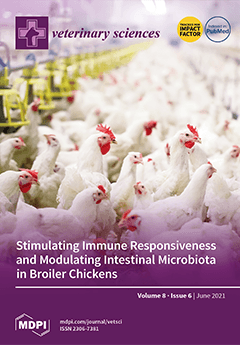Alternatives to the antibiotic fumagillin for the control of
Nosema ceranae, a gut parasite of the honey bee, are needed. The prebiotics eugenol, chitosan, and naringenin and the probiotic Protexin
® (
Enterococcus faecium) provided in sugar syrup or protein patty
[...] Read more.
Alternatives to the antibiotic fumagillin for the control of
Nosema ceranae, a gut parasite of the honey bee, are needed. The prebiotics eugenol, chitosan, and naringenin and the probiotic Protexin
® (
Enterococcus faecium) provided in sugar syrup or protein patty either in spring or fall were evaluated for their effects on
N. ceranae infection, colony population, honey yield and winter survivorship using field colonies. In the first year, spring treatments with eugenol, naringenin, and Protexin
® significantly reduced
N. ceranae infection and increased honey production, while Protexin
® also increased adult bee populations and chitosan was ineffective. Fall treatments increased survivorship and decreased
N. ceranae infection the following spring. In the second year, selected compounds were further tested with a larger number of colonies per treatment and only protein patty used in the spring and sugar syrup in the fall. Protexin
® and naringenin significantly decreased
N. ceranae infections and increased the population of adult bees after spring treatment, but did not affect honey yields. There were no differences between treatments for colony winter mortality, but surviving colonies that had been treated with Protexin
® and naringenin were significantly more populated and had lower
N. ceranae spore counts than control, non-treated colonies. Protexin
® and naringenin were the most promising candidates for controlling
N. ceranae and promoting honey bee populations, warranting further investigation. Future research should investigate the optimal colony dose and treatment frequency to maximize colony health.
Full article






